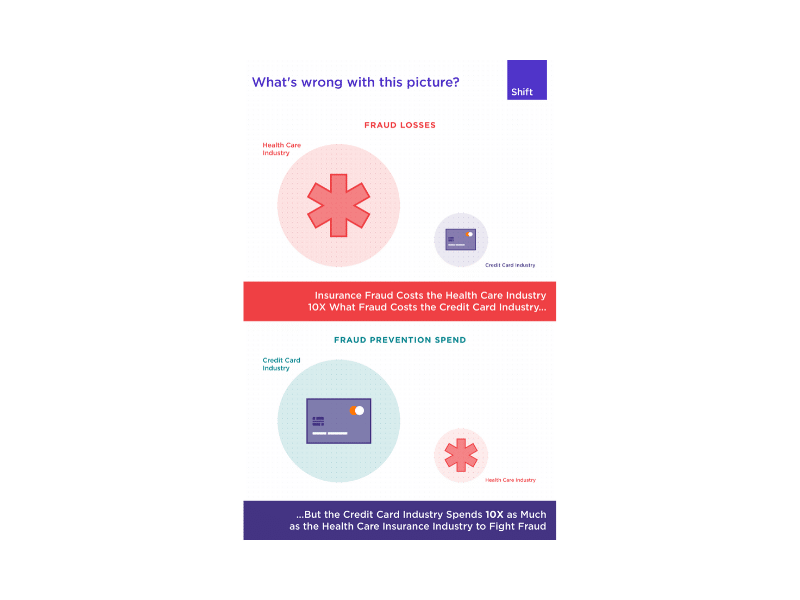Solomon Philip is Shift Technology’s Head of Market Intelligence
Medicare and Medicaid programs provide access to quality healthcare for tens of millions of Americans through programs administered through both the U.S. government as well as a network of hundreds of private payers. These various entities spend more than $1.5 trillion dollars a year to make sure plan participants stay as healthy as possible. Yet, all the good Medicare/Medicaid provides for its members does not shield them from the activities of bad actors seeking to manipulate the system for their own benefit. In fact, fraud, waste, and abuse (FWA) in the public health system represents billions of dollars a year in losses for the various organizations paying for health services for its participants.
FWA schemes are particularly prevalent among Durable Medical Equipment (DME) suppliers. All too often malicious service providers are able to quickly set up shop, do significant damage, and then disappear before their activities are discovered. In many situations, these DME purveyors face fewer barriers to market entry and less stringent licensing and other regulations than out/in patient providers of medical services. This makes for a perfect FWA recipe.
Creating a network of good providers while at the same time identifying and removing dishonest ones is a challenging task. Current systems and processes are not equipped to build, develop and guard this ecosystem of trustworthy providers needed to deliver quality care.
However, there is good news. Advances in artificial intelligence (AI) are bringing new tools to the fight against FWA. AI-powered solutions are ideal for identifying providers who are manipulating the system and targeting it and its members for vulnerabilities. We have seen that AI is capable of applying human-like oversight, but at a massive scale, to search for anomalies, outliers, and suspicious patterns with higher accuracy and speed than traditional detection approaches, improving the system for legitimate providers and their patients.
What Does DME Fraud Typically Look like?
As previously discussed, setting up shop as a DME provider is not terribly difficult. Online commerce even makes it possible to do so without a physical location. The advent and acceptance of remote or telemedicine also plays a significant role in successful DME schemes. Add in unscrupulous telemarketers and with these parties working together, Medicare/Medicaid recipients, and the system itself, become the target for these widespread schemes. And unfortunately, the population receiving these services are particularly vulnerable. They are typically older and they may be less mobile, thus more apt to taking an “easier” approach to acquiring the healthcare equipment they require.
In many DME schemes we find the patient contacted directly by a telemarketer offering any manner of medical equipment - from diabetic testing strips to mobility scooters - all at no charge for Medicare/Medicaid participants. These telemarketers may work directly for the DME supplier or receive a kickback. The telemarketer’s job is to assess eligibility, secure patient participation and capture personal health information, including that relevant for Medicare/Medicaid billing. As most DME orders require at minimum a medical provider’s approval if not a full prescription, this is where telemedicine enters the picture. The Private Health Information (PHI) collected by the telemarketer is provided to a provider offering telemedicine services who delivers the required documentation to process the order. The DME supplier delivers to the patient and bills Medicare/Medicaid.
On the surface, this cycle looks wholly legitimate, which is why it is so hard to spot. Yes, the patient may receive the supplies needed to treat their condition, but what they do not know is that their PHI and Medicare/Medicaid information are now in the hands of scammers. There is very little in the way to stop the DME supplier from using this information along with fraudulent medical notes to bill Medicare/Medicaid for not only unnecessary, but also undelivered medical supplies.
A Multi-level Problem
In light of growing fraud, waste and abuse within Medicare/Medicaid, Congress has given the Centers for Medicare & Medicaid Services (CMS) the authority to reduce the insurers’ reimbursement rates if evidence of consistent overbilling is seen. Additional regulatory oversight, auditing, and reporting requirements do not simply impact nefarious providers. Introducing additional friction into an already complex value chain also negatively impacts legitimate providers and their users. For example, bills have been proposed to grant the government the power to force refunds by plans for incorrect payments. Blunt tactics to stop fraud can result in provider abrasion thereby chasing away honest providers across the value chain, resulting in negative brand recognition for the plan and compromised patient health outcomes.
Spotting and Stopping DME Fraud
Ultimately, Medicare/Medicaid payers must improve the accuracy of claims fraud and reduce the costs incurred pursuing false positives while increasing prepayment efficiency. Investing in the right tools and techniques can help plans quickly and accurately identify FWA earlier in the claims process. As important, tightening pre-pay models to detect and deter bad actors while expediting services and reimbursing payments for the right services for legitimate customers by good providers must be a core tenet for every health plan. Plans may have capabilities to identify known fraud tactics, but that is not enough. Health plans should develop abilities to detect new and emerging oddities in member behavior (such as delivery of DME not related to a patients known ailments) or oddities in coding practices (for example billing for more than the required amount of diabetes strips for type 2 patients). Price per member per month (PMPM) models are a crucial contributor to the abuse in the Medicaid/Medicare space. Such models incentivize charging for unnecessary DME. Health plans must consider moving to value-based care, which rewards “good doctors,” thus building a network of trust-worthy providers that increase the quality of care and decrease costs. Furthermore, plans must invest in providing education to ensure good billing practices and build a smarter, more robust network of good doctors. Sifting out bad providers and sketchy services used to target marginalized customers through stringent credentialing is critical to ensure the safety and security of the at-risk customer segments.
Where does AI fit into the equation?
AI scales a health plan's ability to detect aberrant behaviors by providers across thousands of claims while ensuring the accuracy and explainability of each alert in real-time. Many DME scams rely on the simple fact that on the surface they look legitimate. The patient is a legitimate Medicare/Medicaid patient with current, up-to-date identification. The DME provider has followed the limited rules they need to establish the business and billing is done with a doctor’s note or prescription from a credentialed provider. Scammers take full advantage of this.
Traditional approaches to FWA simply are not up to the task of reviewing and analyzing all the data required to spot the kind of anomalies represented by many DME scams. AI is. AI-powered FWA mitigation strategies are able to not only review the claim to determine if it “looks” legitimate, but also additional member and third-party data that presents a more complete picture of the claim - see my earlier example about billing for DME unneeded by the patient’s actual diagnosis.
Perhaps even more important is the ability for AI to make the connections between ecosystem participants to identify networks of suspicious providers conducting fraud on a major scale. Stopping and ultimately preventing FWA is an excellent first step to protecting patients targeted by criminal providers.
In addition to specifically fighting DME fraud, access to data combined with recent strides in AI allows Medicare/Medicaid payers to more easily analyze patient and provider claim history and leverage predictive capabilities to recommend provider education steps, identify alternative care approaches which may not have been tried, all in an effort to achieve better outcomes. Additionally, AI supports ongoing communication with providers and the education required to improve billing patterns.
Conclusion
Looking for fraud in public health programs can be like looking for a needle in a needle stack; there can be a lot of it, but you need to know what you are looking for to find it. AI shines when looking for apriori criminal schemes not previously known by flagging anomalies, just like humans do. However, the application of the method can be done at a massive scale using technology such as AI. AI empowers payers to build a robust network of good providers, rendering quality care to its constituents while stopping bad ones from leeching on the system. Health plans must pay careful attention to new capabilities now available due to recent advances that make it possible to make a difference. If done well, fraud, waste, and abuse can be proactively stopped at the pre-pay level instead of relying on the more standard pay-and-chase approach employed by payers currently. Finally, the application of AI benefits good providers, protecting them, removing friction in the process, and allowing them to do what they are meant to do: support and serve the community most in need of help and care.


